The problem with ESG investing, in one chart
Investors poured more than $120 billion this year into exchange-traded funds marketed as comprising companies with strong environmental, social, and governance (ESG) track records. That’s double last year’s level, and total investment in ESG ETFs could reach $1 trillion by 2025, according to Bloomberg, making them one of the hottest investment products on the market.


Investors poured more than $120 billion this year into exchange-traded funds marketed as comprising companies with strong environmental, social, and governance (ESG) track records. That’s double last year’s level, and total investment in ESG ETFs could reach $1 trillion by 2025, according to Bloomberg, making them one of the hottest investment products on the market.
These funds ostensibly drive capital toward socially and environmentally conscious corporations, and allow their owners—for the most part, pension funds and other large institutional investors—to claim they are reducing their investment in unethical or destructive companies. But BlackRock and the other asset managers that compile the most popular of these funds don’t always agree on what “ESG” really means or how to build a portfolio around it. As a result, many ESG ETFs have a carbon footprint that is scarcely lower than the S&P 500.
That’s according to an analysis by Jordan Waldrep, chief investment officer of Illinois-based TrueMark Investments. Using emissions data disclosed by companies, Waldrep calculated the carbon intensity—measured as CO2 emissions per $1 million in revenue—of companies held by several popular ESG ETFs. By averaging these data across each ETF, he was able to compare them, with the S&P 500 acting as a benchmark. The funds Waldrep analyzed were less carbon-intense than the S&P, largely because they exclude most major oil and gas companies. But many ESG ETFs were still more carbon-intense than a hypothetical fund that precisely tracked the S&P but excluded the five dirtiest companies in each sector. As Waldrep put it, “That says they’re not really trying.”
A key problem is that portfolio managers, even of ESG funds, typically assign very little weight to a company’s climate performance, according to a comprehensive analysis (pdf) in August by economists at EDHEC Business School in France. The analysts found that market cap is still by far the most important factor in whether a company is included in a fund, and at what volume. Other “ESG” issues like equitable pay for female employees also tend to outrank climate considerations. The upshot, the report said, is that any climate-labeled fund not using climate data for at least half of its stock weighting determinations “should be considered to be at a significant risk of greenwashing.”
Ratings firms that assign the ESG scores underlying these portfolios also sometimes rely on a misleading interpretation of corporate data that is more concerned with how a company will be affected by climate change than vice-versa, according to a recent Bloomberg investigation.
But the green paint job may soon get a closer look from regulators: The US Securities and Exchange Commission is already investigating Deutsch Bank’s asset management arm over allegations that it may have overstated its products’ ESG credentials, and regulators in the US, Europe, and elsewhere are considering new rules for ESG disclosure and labeling.